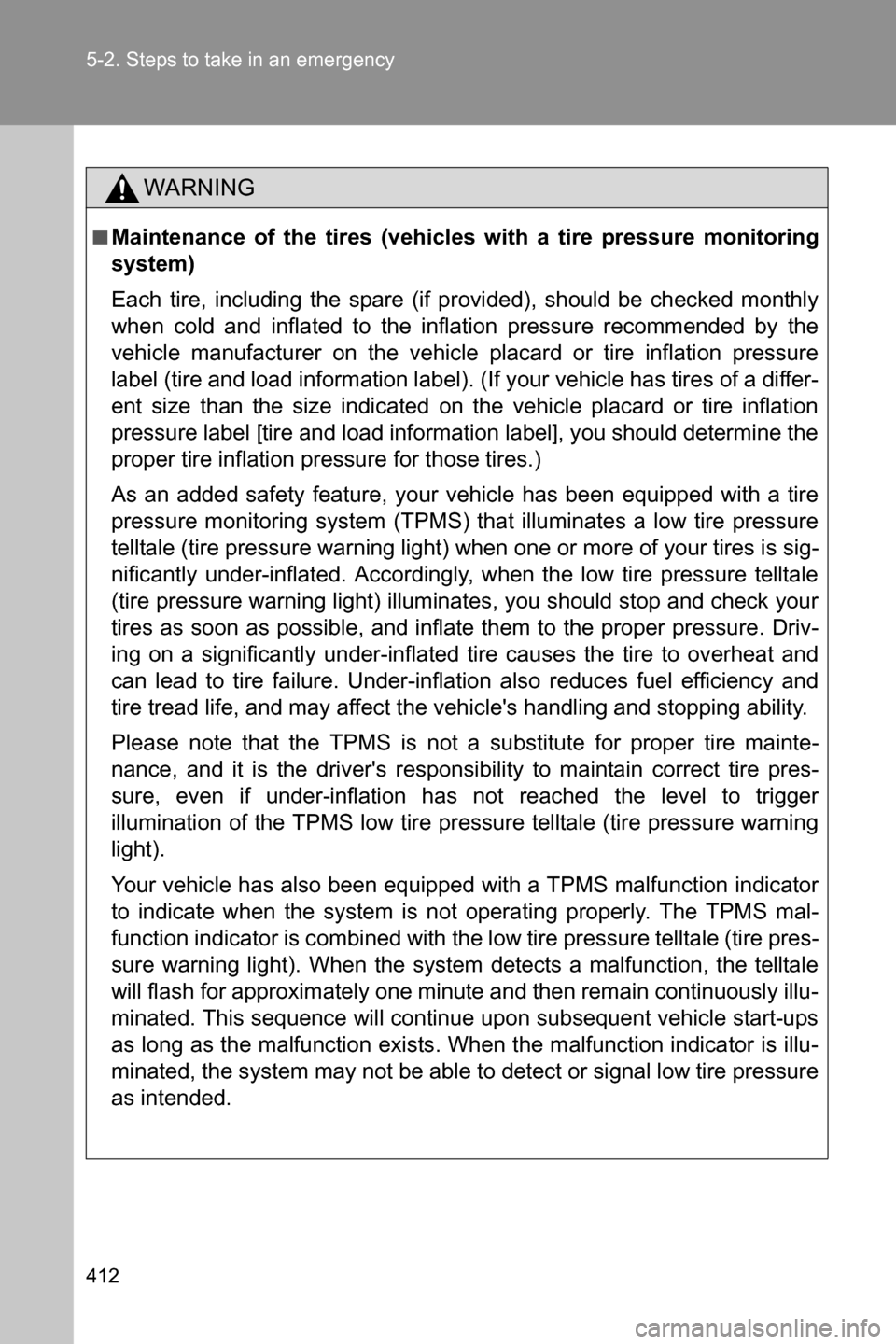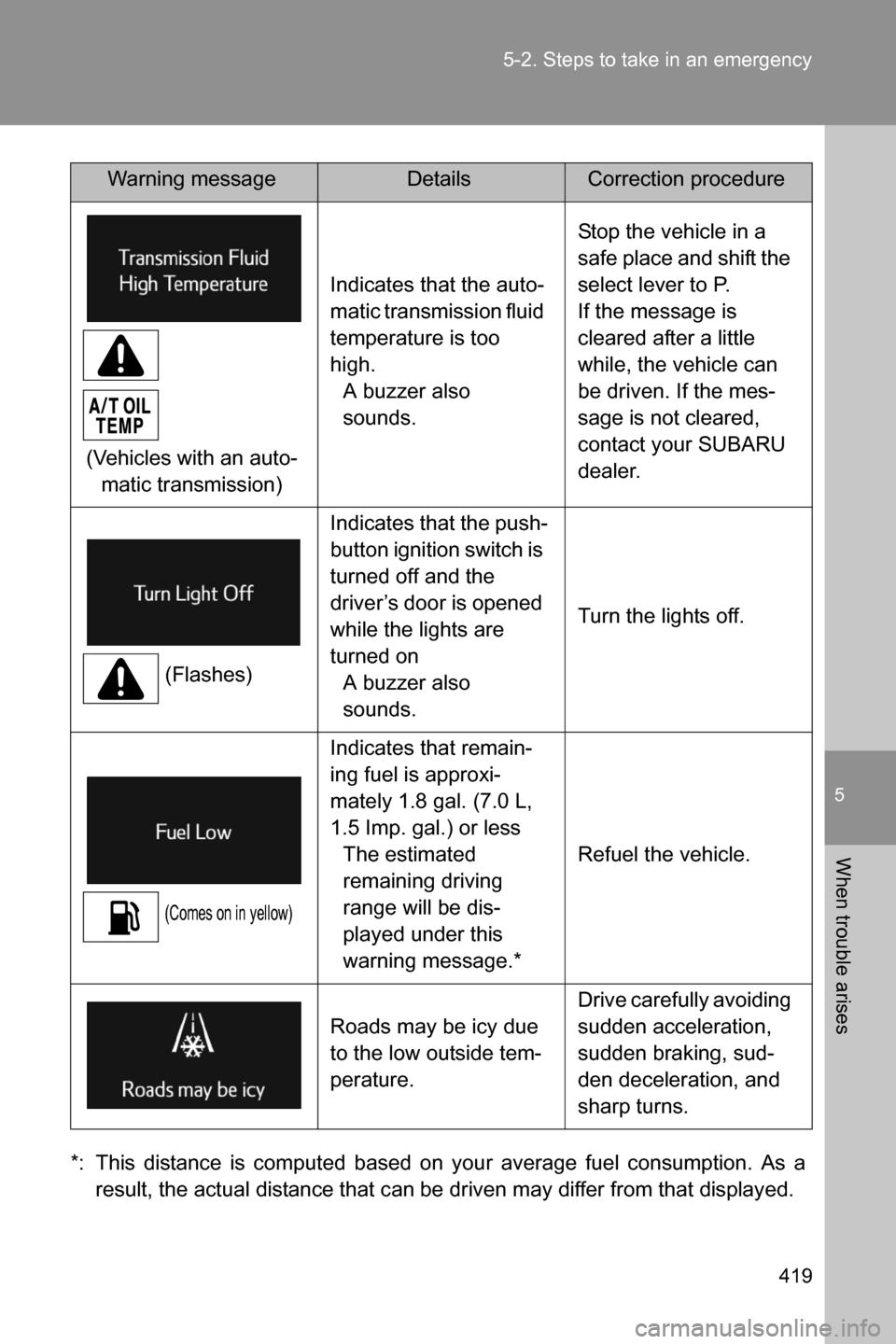Page 412 of 540

410 5-2. Steps to take in an emergency
■If the tire pressure monitoring system is inoperative (if equipped)
The tire pressure monitoring system will be disabled in the following con-
ditions:
(When the condition becomes normal, the system will work properly.)
●If tires not equipped with tire pressure warning valves and transmit-
ters are used.
●If the ID code on the tire pressure warning valves and transmitters is
not registered in the tire pressure warning computer.
●If the tire inflation pressure is 55 psi (380 kPa, 3.87 kgf/cm2 or bar) or
higher.
The tire pressure monitoring system may be disabled in the following
conditions:
(When the condition becomes normal, the system will work properly.)
●If electronic devices or facilities using similar radio wave frequencies
are nearby.
●If a radio set at similar frequencies is in use in the vehicle.
●If a window tint that affects the radio wave signals is installed.
●If there is a lot of snow or ice on the vehicle, in particular around the
wheels or wheel housings.
●If non-genuine SUBARU wheels are used. (Even if you use SUBARU
wheels, the tire pressure monitoring system may not work properly
with some types of tires.)
●If tire chains are used.
●If a large metallic object which can interfere with signal reception is
put in the trunk.
■If the tire pressure warning light frequently comes on after blinking
for approximately one minute (if equipped)
If the tire pressure warning light frequently comes on after blinking for
approximately one minute when the push-button ignition switch is turned
to “ON” mode (vehicles with a keyless access with push button start sys-
tem) or the engine switch is turned to the “ON” position (vehicles without
a keyless access with push button start system), have it checked your
SUBARU dealer.
Page 413 of 540
5
When trouble arises
411 5-2. Steps to take in an emergency
WARNING
■If the tire pressure warning light comes on (if equipped)
Be sure to observe the following precautions. Failure to do so could
cause loss of vehicle control and result in death or serious injury.
●Stop your vehicle in a safe place as soon as possible. Adjust the tire
inflation pressure immediately.
●If the tire pressure warning light comes on even after tire inflation pres-
sure adjustment, it is probable that you have a flat tire. Check the tires.
If the tire is flat, change to the spare tire and have the flat tire repaired
by the nearest SUBARU dealer.
●Avoid abrupt maneuvering and braking. If the vehicle tires deteriorate,
you could lose control of the steering wheel or the brakes.
■If a blowout or sudden air leakage should occur (vehicles with a tire
pressure monitoring system)
The tire pressure monitoring system may not activate immediately.
Page 414 of 540

412 5-2. Steps to take in an emergency
WARNING
■Maintenance of the tires (vehicles with a tire pressure monitoring
system)
Each tire, including the spare (if provided), should be checked monthly
when cold and inflated to the inflation pressure recommended by the
vehicle manufacturer on the vehicle placard or tire inflation pressure
label (tire and load information label). (If your vehicle has tires of a differ-
ent size than the size indicated on the vehicle placard or tire inflation
pressure label [tire and load information label], you should determine the
proper tire inflation pressure for those tires.)
As an added safety feature, your vehicle has been equipped with a tire
pressure monitoring system (TPMS) that illuminates a low tire pressure
telltale (tire pressure warning light) when one or more of your tires is sig-
nificantly under-inflated. Accordingly, when the low tire pressure telltale
(tire pressure warning light) illuminates, you should stop and check your
tires as soon as possible, and inflate them to the proper pressure. Driv-
ing on a significantly under-inflated tire causes the tire to overheat and
can lead to tire failure. Under-inflation also reduces fuel efficiency and
tire tread life, and may affect the vehicle's handling and stopping ability.
Please note that the TPMS is not a substitute for proper tire mainte-
nance, and it is the driver's responsibility to maintain correct tire pres-
sure, even if under-inflation has not reached the level to trigger
illumination of the TPMS low tire pressure telltale (tire pressure warning
light).
Your vehicle has also been equipped with a TPMS malfunction indicator
to indicate when the system is not operating properly. The TPMS mal-
function indicator is combined with the low tire pressure telltale (tire pres-
sure warning light). When the system detects a malfunction, the telltale
will flash for approximately one minute and then remain continuously illu-
minated. This sequence will continue upon subsequent vehicle start-ups
as long as the malfunction exists. When the malfunction indicator is illu-
minated, the system may not be able to detect or signal low tire pressure
as intended.
Page 416 of 540
414
5-2. Steps to take in an emergency
If a warning message is displayed (vehicles with a color multi-infor mation display)
Stop the vehicle immediately. Continuing to drive the vehicle
may be dangerous.
The following warning indicates a possible problem in the brake sys-
tem. Immediately stop the vehicle in a safe place and contact your
SUBARU dealer.
Warning messageDetails
(U.S.A.)
(Canada and Mexico)
Indicates that:
• The brake fluid level is low; or
• The brake system is malfunctioning
A buzzer also sounds.
If a warning is shown on the multi-information display, stay calm and
perform the following actions:
Master warning light
The master warning light also
comes on or flashes in order to
indicate that a message is cur-
rently being displayed on the
multi-information display.
Multi-information display
If any of the warning light comes on again after the following
actions have been performed, contact your SUBARU dealer.
Page 420 of 540
418 5-2. Steps to take in an emergency
Follow the correction procedures.
After taking the specified steps to correct the suspected problem,
check that the warning message and light go off.
Warning messageDetailsCorrection procedure
Indicates that one or
more of the doors is
not fully closed
The system also indi-
cates which doors are
not fully closed.
If the vehicle reaches
a speed of 3 mph (5
km/h),
flashes and a buzzer
sounds to indicate
that the door(s) are
not yet fully closed.Make sure that both
side doors are closed.
Indicates that the trunk
is not fully closed
If the vehicle reaches
a speed of 3 mph (5
km/h),
flashes and a buzzer
sounds to indicate
that the trunk is not
yet fully closed.Close the trunk.
Page 421 of 540

5
When trouble arises
419 5-2. Steps to take in an emergency
*: This distance is computed based on your average fuel consumption. As a
result, the actual distance that can be driven may differ from that displayed. (Vehicles with an auto-
matic transmission)Indicates that the auto-
matic transmission fluid
temperature is too
high.
A buzzer also
sounds.Stop the vehicle in a
safe place and shift the
select lever to P.
If the message is
cleared after a little
while, the vehicle can
be driven. If the mes-
sage is not cleared,
contact your SUBARU
dealer.
(Flashes)Indicates that the push-
button ignition switch is
turned off and the
driver’s door is opened
while the lights are
turned on
A buzzer also
sounds.Turn the lights off.
(Comes on in yellow)
Indicates that remain-
ing fuel is approxi-
mately 1.8 gal. (7.0 L,
1.5 Imp. gal.) or less
The estimated
remaining driving
range will be dis-
played under this
warning message.*Refuel the vehicle.
Roads may be icy due
to the low outside tem-
perature.Drive carefully avoiding
sudden acceleration,
sudden braking, sud-
den deceleration, and
sharp turns.
Warning messageDetailsCorrection procedure
Page 422 of 540
420 5-2. Steps to take in an emergency
Have the malfunction repaired immediately.
After taking the specified steps to correct the suspected problem,
check that the warning message and light go off.
Interior
buzzerExterior
buzzerWarning messageDetailsCorrection
procedure
Once�
(Flashes)
(Flashes in yellow)
Indicates that the
access key is not
present when
attempting to
start the engine.Confirm
the loca-
tion of the
access
key.
Once
3 times
(Flashes)
(Flashes in yellow)
Indicates that a
door other than
the driver’s door
has been opened
and closed with
the push-button
ignition switch in
any mode other
than off and the
access key out-
side of the detec-
tion area.Confirm
the loca-
tion of the
access
key.
Page 429 of 540
5
When trouble arises
427 5-2. Steps to take in an emergency
��Power was
turned off due to
the automatic
power off func-
tion.Next time
when
starting
the
engine,
increase
the engine
speed
slightly
and main-
tain that
level for
approxi-
mately 5
minutes to
recharge
the bat-
tery.
Once�
(Flashes in yellow)
Indicates that the
access key bat-
tery is low.Replace
the bat-
tery.
(�oP. 367)
Interior
buzzerExterior
buzzerWarning messageDetailsCorrection
procedure